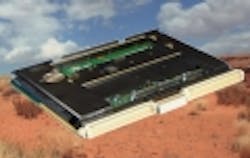Optical databus interface for rugged avionics applications is aim of C-MAC/Ultra Communications partnership
OLD AMERSHAM, England, 13 Oct. 2010. C-MAC MicroTechnology in Old Amersham, England, is working together with Ultra Communications Inc. in Vista, Calif., to develop state-of-the-art 10-gigabit-per-second optical transmit and receive avionics databus interface modules for military and space applications.
C-MAC experts developed the STANAG 3910 optical transceiver for the Eurofighter combat jet, and plan to capitalize on that optical avionics databus technology to design and manufacture next-generation optical databus products for defense, aerospace, and space applications in existing and future systems in harsh environments, company officials say.
This optical databus interface is for all existing and planned avionics optical databus requirements for the foreseeable future. C-MAC's transceiver initially will provide four transmit and four receive optical channels each running at 2.5 gigabits per second using the Ultra Communications optical core. The device will be packaged in a hermetic enclosure and qualified to international military and space standards and the evolving JEDEC standards.
"This development with C-MAC will set the bar for ruggedized fiber optic transceivers and in the future," says Chuck Tabbert, vice president sales and marketing at Ultra Communications. "We believe C-MAC's MIL-PRF 38534 hybrid capability and our optical engine roadmaps are a perfect fit for the expanding high bandwidth data rate needs of advanced satellites, and avionics.
C-MAC builds high-reliability electronic systems, modules, and components for harsh environments such as extremes of temperature, vibration and shock. Ultra Communications develops fast photonic components for harsh environment applications such as satellites, military and commercial aircraft, unmanned aerial vehicles (UAVs), and missiles. The company is a 2005 spin-out of Peregrine Semiconductor.
For more information contact C-MAC online at www.cmac.com, or Ultra Communications at www.ultracomm-inc.com.
